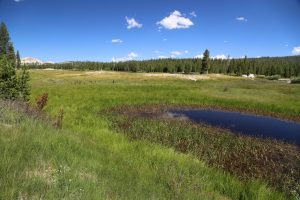Mariposa Sequoia Grove is the largest grove in the area and is located just 2 miles from the southern park entrance along Highway 41. Note that the Mariposa Grove Road is closed during the winter so you have to park at the park’s south entrance and walk 4 miles roundtrip to the grove. This grove is also home to the Grizzly Giant, one of the largest Sequoia trees in the world.
Another place to visit these giant trees is at the smaller Tuolumne Grove of Sequoia trees off of Highway 120 in Tuolumne County near the junction of Big Oak Flat and Tioga Roads. There is a well marked but steep path that that leads down the hill for about a mile to the main part of the grove. Allow at least 90 minutes for this hike including peaceful time to marvel at these massive giants. This is a lesser visited grove in comparison to the Mariposa Sequoias. For comparison the Tuolumne grove has about 25 giant trees whereas the Mariposa Grove has over 500. These trees can live up to 3,000 years old and some of the biggest ones have trunks that are up to 35 feet in diameter.
Glacier Point is one of the park’s quintessential view points with exhilarating close-up views of Half Dome, parts of the Valley and the high country. Glacier Point Road leads off of Highway 41. This is about an hours drive from the valley floor. The great view and lookout is accessed by a short paved trail.
Olmstead Point is located off of Highway 120 on the way to Tioga Pass. This is another one of those fantastic Yosemite overviews. The angle is completely different than say Glacier Point and you see more of the back and side of half dome from here rather than its front. Olmstead Point is also located within minutes of Tenaya Lake one of the more picturesque easily accessible (right next to the road) Yosemite lakes. From the parking lot at the point, one looks into Tenaya Canyon and can see some f the granite features surrounding the actual valley floor. From here it is at least an hour drive into the valley floor.
Tioga Pass is California’s highest paved highway clocking in at just a nudge under 10,000 feet (although note there is a short paved section of roadway higher in the White Mountains to the south that clocks in at over 11,000 feet).
Highway 120 winds through dramatic rocky and rugged landscape to the east of Tioga Pass. This road is an impressive piece of engineering. The eastern entrance to Yosemite Park is located at Tioga Pass (directly on Highway 120). This seasonal highway is generally open from the end of May through mid to the end of October. It is closed the rest of the year due to snow. This road crosses some of the most beautiful high country terrain in all of Yosemite and is a great example of the geography of the Sierra Nevada. By this we mean the highway dramatically rises several thousand feet from the east in a relatively short distance while to the west the highway features a much longer gradual decline.
Tuolomne Meadows sits at an elevation of over 8600 feet and is a major hub for a series of back country hiking trails to various lakes, scenic granite vistas and of course the picturesque meadows themselves. Very popular with both day hikers and long distance backpackers. Some of the most popular hikes in the area include Cathedral Lakes, Dog Lake, Lembert Dome, Lyell Canyon, Elizabeth Lake, Gaylor Lake, Glen Aulin, Mono Pass and Vogelsang High Sierra Camp. These day hikes range from and hour to 8+ hours.
Access to the meadows is limited to when Highway 120 (Tioga Pass Road) is open which typically is from the end of May through the mid to end of October. The actual meadow is quite scenic (with the Tuolumne River running through it), it is several miles in length and during the high country “spring” in mid summer you will see a number of wildflowers. This an excellent picnic location.
The Tuolomne Meadows Visitor Center is located here – parking is limited to only 30 minutes at a time. But pop in side for the latest on hiking suggestions and weather updates.
Yosemite Mountain Sugar Pine Railroad is a throwback to the era of big timber logging. This steam train and museum is located in Fish Camp along Highway 41 just outside the south entrance to Yosemite National Park. This is family owned and is the site of the old Madera Sugar Pine Lumber Company. This sawmill operated from 1899 to 1931 and during that time narrow gauge railway was used for transporting recently harvested timber. A 54 mile long flume (narrow waterway) was built to float the raw cut wood down to a sawmill in Madera (central valley). Today 4 miles of the narrow gauge railway are still in operation, not as transportation for milled lumber, but rather for sightseeing and an experience that is a throwback to the turn of the last century.
The vintage steam powered train ride takes about 1 hour with cars that are both open to the air as well as covered. Your trip will be through a dense forest; this is a great ride to simply relax and take in the scenery and is sure to be enjoyed by children. The train will stop about halfway to fill up with water. A restaurant (good BBQ) is on site with picnic style dining, the Thornberry museum displays a number of train memorabilia as well as other local historical items and a gift shop offers an excellent selection of hard to find books about local history.
Visit their website for schedules and descriptions: www.ymsprr.com

















Leave a Reply